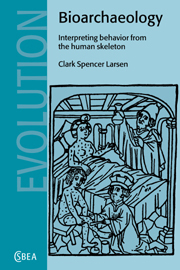Book contents
- Frontmatter
- Contents
- Acknowledgments
- 1 Introduction
- 2 Stress and deprivation during the years of growth and development and adulthood
- 3 Exposure to infectious pathogens
- 4 Injury and violent death
- 5 Activity patterns: 1. Articular and muscular modifications
- 6 Activity patterns: 2. Structural adaptation
- 7 Masticatory and nonmasticatory functions: craniofacial adaptation
- 8 Isotopic and elemental signatures of diet and nutrition
- 9 Historical dimensions of skeletal variation: tracing genetic relationships
- 10 Changes and challenges in bioarchaeology
- References
- General index
- Site index
5 - Activity patterns: 1. Articular and muscular modifications
Published online by Cambridge University Press: 05 June 2012
- Frontmatter
- Contents
- Acknowledgments
- 1 Introduction
- 2 Stress and deprivation during the years of growth and development and adulthood
- 3 Exposure to infectious pathogens
- 4 Injury and violent death
- 5 Activity patterns: 1. Articular and muscular modifications
- 6 Activity patterns: 2. Structural adaptation
- 7 Masticatory and nonmasticatory functions: craniofacial adaptation
- 8 Isotopic and elemental signatures of diet and nutrition
- 9 Historical dimensions of skeletal variation: tracing genetic relationships
- 10 Changes and challenges in bioarchaeology
- References
- General index
- Site index
Summary
Introduction
Physical activity is a defining characteristic of human adaptive regimes. Hunter-gatherers, for example, are often characterized as highly mobile, hard-working, and barely able to eke out an existence. In contrast, agriculturalists are seen as having it pretty good – they are settled in one place, they have plenty to eat, and their work loads are light. In his popular and influential archaeology textbook, Braidwood (1967:113) distinguished hunter-gatherers as leading ‘a savage's existence, and a very tough one … following animals just to kill them to eat, or moving from one berry patch to another (and) living just like an animal’. Ethnographic and other research calls into question these simplistic portrayals of economic systems. Following the publication of Lee & DeVore's (1968) Man the Hunter conference volume, and especially Lee's (1979) provocative findings regarding work behavior and resource acquisition among the !Kung in northern Botswana, a consensus emerged that, contrary to the traditional Hobbesian depiction of hunter-gatherer lifeways as ‘nasty, brutish, and short’, prehistoric foragers were not subject to overbearing amounts of work, and life overall for them was leisurely, plentiful, and confident (see Sahlins, 1972). More importantly, these developments fostered a wider discussion of activity and physical behavior in humans, present and past, leading to the conclusion that human adaptive systems are highly variable.
- Type
- Chapter
- Information
- BioarchaeologyInterpreting Behavior from the Human Skeleton, pp. 161 - 194Publisher: Cambridge University PressPrint publication year: 1997



